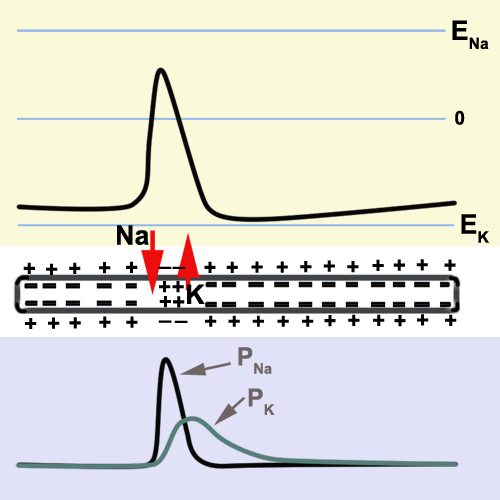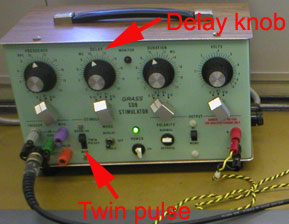|
Compound Action Potential |
Refractory period |
| |
For a short period after the
passage of an impulse, the threshold for stimulation is raised, such
that if a nerve is stimulated twice in quick succession, it may not
respond to the second stimulus. |
|
|
|
|
|
|
|
The absolute
refractory period is the brief interval after a successful
stimulus when no second shock, however maximal, can elicit another
response. Its duration in mammalian A fibres is about 0.4 ms; in frog
nerve at 15oC it is about 2 ms. The absolute refractory
period is followed by the relative refractory
period, during which a second response can be obtained if a
strong enough shock is applied. |
|
Thus, the refractoriness of a nerve after
conducting an impulse sets an upper limit to spike frequency. During the
relative refractory period, two impulses traversing a long length of
nerve must be separated by a minimal interval if the second spike is to
be full sized. |
|
The inactivation of Na+ channels
and the delayed increase in K+ conductance are the underlying
ionic conductance changes which can explain the refractory period. |

The diagram above shows the Time relations
of the events during the propagation of the action potential
(intracellular recording), the ionic movements (Na+ in and K+
out) and the membrane permeability. |
|
|
|
|
The output of the stimulator is set to
"Twin" instead of "single" pulse. In this mode, the stimulator sends out
pairs of pulses of identical intensity, at intervals set by the delay
knob. As a result, the first stimulus coincides with the start of the
sweep. |
 |
|
|
Click here to view an experimental recording
of the refractory period determination |
|
|
|
|
In the above experimental recording, the
nerve was crushed between the proximal recording electrodes. Why? |
|
The above experimental recording showed the
refractory period of an average A-alpha fibre. How would the
refractory period compare with that of an A-beta fibre? |
|
How would you demonstrate the refractory
period of an average A-beta fibre? |
|
|
|
Click here to return to the Virtual lab home
page |